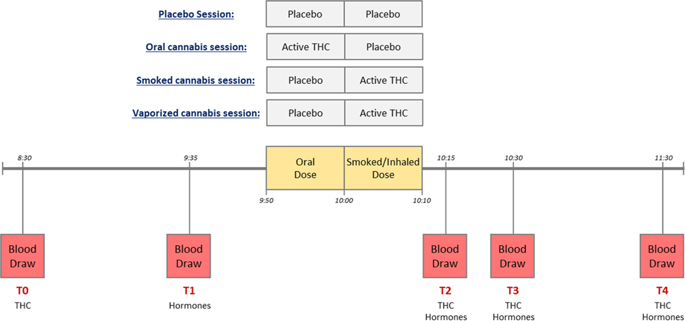当前位置:
X-MOL 学术
›
Transl. Psychiaty
›
论文详情
Our official English website, www.x-mol.net, welcomes your feedback! (Note: you will need to create a separate account there.)
Effects of oral, smoked, and vaporized cannabis on endocrine pathways related to appetite and metabolism: a randomized, double-blind, placebo-controlled, human laboratory study.
Translational Psychiatry ( IF 6.8 ) Pub Date : 2020-02-19 , DOI: 10.1038/s41398-020-0756-3 Mehdi Farokhnia 1, 2, 3 , Gray R McDiarmid 1 , Matthew N Newmeyer 3, 4 , Vikas Munjal 1 , Osama A Abulseoud 4 , Marilyn A Huestis 4, 5 , Lorenzo Leggio 1, 2, 6, 7
Translational Psychiatry ( IF 6.8 ) Pub Date : 2020-02-19 , DOI: 10.1038/s41398-020-0756-3 Mehdi Farokhnia 1, 2, 3 , Gray R McDiarmid 1 , Matthew N Newmeyer 3, 4 , Vikas Munjal 1 , Osama A Abulseoud 4 , Marilyn A Huestis 4, 5 , Lorenzo Leggio 1, 2, 6, 7
Affiliation

|
As perspectives on cannabis continue to shift, understanding the physiological and behavioral effects of cannabis use is of paramount importance. Previous data suggest that cannabis use influences food intake, appetite, and metabolism, yet human research in this regard remains scant. The present study investigated the effects of cannabis administration, via different routes, on peripheral concentrations of appetitive and metabolic hormones in a sample of cannabis users. This was a randomized, crossover, double-blind, placebo-controlled study. Twenty participants underwent four experimental sessions during which oral cannabis, smoked cannabis, vaporized cannabis, or placebo was administered. Active compounds contained 6.9 ± 0.95% (~50.6 mg) ∆9-tetrahydrocannabinol (THC). Repeated blood samples were obtained, and the following endocrine markers were measured: total ghrelin, acyl-ghrelin, leptin, glucagon-like peptide-1 (GLP-1), and insulin. Results showed a significant drug main effect (p = 0.001), as well as a significant drug × time-point interaction effect (p = 0.01) on insulin. The spike in blood insulin concentrations observed under the placebo condition (probably due to the intake of brownie) was blunted by cannabis administration. A significant drug main effect (p = 0.001), as well as a trend-level drug × time-point interaction effect (p = 0.08) was also detected for GLP-1, suggesting that GLP-1 concentrations were lower under cannabis, compared to the placebo condition. Finally, a significant drug main effect (p = 0.01) was found for total ghrelin, suggesting that total ghrelin concentrations during the oral cannabis session were higher than the smoked and vaporized cannabis sessions. In conclusion, cannabis administration in this study modulated blood concentrations of some appetitive and metabolic hormones, chiefly insulin, in cannabis users. Understanding the mechanisms underpinning these effects may provide additional information on the cross-talk between cannabinoids and physiological pathways related to appetite and metabolism.
中文翻译:

口服,烟熏和汽化大麻对与食欲和代谢有关的内分泌途径的影响:一项随机,双盲,安慰剂对照的人体实验室研究。
随着对大麻的看法不断变化,了解大麻使用的生理和行为影响至关重要。先前的数据表明,大麻的使用会影响食物的摄入,食欲和新陈代谢,但是在这方面的人类研究仍然很少。本研究调查了通过不同途径服用大麻对大麻使用者样本中周围激素和代谢激素浓度的影响。这是一项随机,交叉,双盲,安慰剂对照的研究。二十名参与者进行了四个实验阶段,在此期间口服了大麻,烟熏大麻,汽化大麻或安慰剂。活性化合物含有6.9±0.95%(〜50.6 mg)∆9-四氢大麻酚(THC)。获得了重复的血液样本,并测量以下内分泌标记物:总生长素释放肽,酰基生长素释放肽,瘦素,胰高血糖素样肽1(GLP-1)和胰岛素。结果显示对胰岛素具有显着的药物主要作用(p = 0.001),以及显着的药物×时间点相互作用(p = 0.01)。在大麻安慰剂条件下观察到的血液中胰岛素浓度的峰值(可能是由于布朗尼的摄入)被抑制了。对于GLP-1,还检测到了显着的药物主要作用(p = 0.001),以及趋势水平药物×时间点相互作用的作用(p = 0.08),这表明与大麻相比,GLP-1的浓度较低安慰剂的情况。最后,发现总的生长素释放肽具有显着的药物主要作用(p = 0.01),这表明口服大麻期间的总生长素释放肽浓度高于熏制和汽化大麻。总而言之,在这项研究中,大麻的使用可以调节大麻使用者的某些食欲和代谢激素(主要是胰岛素)的血药浓度。了解支持这些作用的机制可能会提供有关大麻素与食欲和代谢相关的生理途径之间的相互影响的其他信息。
更新日期:2020-02-19
中文翻译:

口服,烟熏和汽化大麻对与食欲和代谢有关的内分泌途径的影响:一项随机,双盲,安慰剂对照的人体实验室研究。
随着对大麻的看法不断变化,了解大麻使用的生理和行为影响至关重要。先前的数据表明,大麻的使用会影响食物的摄入,食欲和新陈代谢,但是在这方面的人类研究仍然很少。本研究调查了通过不同途径服用大麻对大麻使用者样本中周围激素和代谢激素浓度的影响。这是一项随机,交叉,双盲,安慰剂对照的研究。二十名参与者进行了四个实验阶段,在此期间口服了大麻,烟熏大麻,汽化大麻或安慰剂。活性化合物含有6.9±0.95%(〜50.6 mg)∆9-四氢大麻酚(THC)。获得了重复的血液样本,并测量以下内分泌标记物:总生长素释放肽,酰基生长素释放肽,瘦素,胰高血糖素样肽1(GLP-1)和胰岛素。结果显示对胰岛素具有显着的药物主要作用(p = 0.001),以及显着的药物×时间点相互作用(p = 0.01)。在大麻安慰剂条件下观察到的血液中胰岛素浓度的峰值(可能是由于布朗尼的摄入)被抑制了。对于GLP-1,还检测到了显着的药物主要作用(p = 0.001),以及趋势水平药物×时间点相互作用的作用(p = 0.08),这表明与大麻相比,GLP-1的浓度较低安慰剂的情况。最后,发现总的生长素释放肽具有显着的药物主要作用(p = 0.01),这表明口服大麻期间的总生长素释放肽浓度高于熏制和汽化大麻。总而言之,在这项研究中,大麻的使用可以调节大麻使用者的某些食欲和代谢激素(主要是胰岛素)的血药浓度。了解支持这些作用的机制可能会提供有关大麻素与食欲和代谢相关的生理途径之间的相互影响的其他信息。



























 京公网安备 11010802027423号
京公网安备 11010802027423号